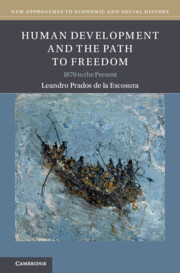Book contents
- Human Development and the Path to Freedom
- New Approaches to Economic and Social History
- Human Development and the Path to Freedom
- Copyright page
- Dedication
- Epigraph
- Contents
- Figures
- Tables
- Preface
- Introduction
- Part I An Aggregate View
- 1 Augmented Human Development: What Is It? How to Measure It?
- 2 Trends in Human Development
- 3 World Distribution of Human Development
- Part II The OECD and the Rest
- Postscript
- Book part
- Notes
- References
- Index
3 - World Distribution of Human Development
from Part I - An Aggregate View
Published online by Cambridge University Press: 14 July 2022
- Human Development and the Path to Freedom
- New Approaches to Economic and Social History
- Human Development and the Path to Freedom
- Copyright page
- Dedication
- Epigraph
- Contents
- Figures
- Tables
- Preface
- Introduction
- Part I An Aggregate View
- 1 Augmented Human Development: What Is It? How to Measure It?
- 2 Trends in Human Development
- 3 World Distribution of Human Development
- Part II The OECD and the Rest
- Postscript
- Book part
- Notes
- References
- Index
Summary
How has Augmented Human Development been distributed across countries? Chapter 3 offers an answer. It presents long-run inequality trends for AHDI and its dimensions and examines gains across the distribution using growth incidence curves, in absolute and relative terms. Augmented human development inequality declined since 1900. In the long run, countries in the middle and lower deciles obtained larger relative gains over the last century. Over time, changes in the international distribution of augmented human development largely depended on the behaviour of schooling and civil and political liberties, even though life expectancy was inequality’s main driver until the 1920s since the uneven diffusion of new medical knowledge and technology and health practices in the early stages of the epidemiological transition provoked unequal life expectancy gains. The global spread of schooling and the diffusion of epidemiological transition made a substantial contribution to reducing AHD inequality between the 1920s and the early 1980s. The rise of authoritarian political regimes partly offset AHD inequality decline, since its dispersion only fell from the 1970s. These findings are at odds with the evolution of per capita income dispersion that increased until the late twentieth century and only fell since 1990. (198 words)
Keywords
- Type
- Chapter
- Information
- Human Development and the Path to Freedom1870 to the Present, pp. 65 - 96Publisher: Cambridge University PressPrint publication year: 2022



